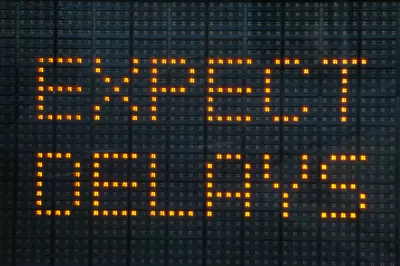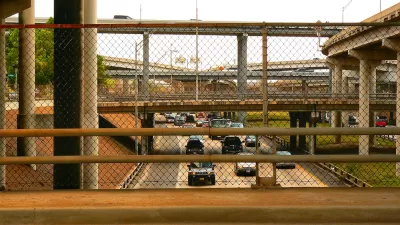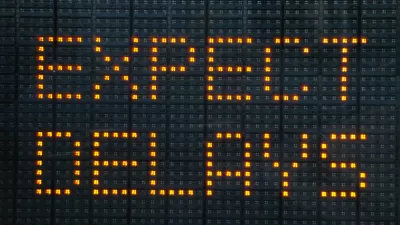The new INRIX congestion costing report is another good example of bad analysis. We just want accurate information; hold the hyperbole, please.

INRIX provides traffic data that drivers can use to anticipate and avoid congestion. Many motorists and businesses willingly pay for this valuable information. So why must they exaggerate congestion costs? It’s a classic case of overselling.
INRIX just released a report, Counting the Future Costs of Gridlock: The Economic Impacts of Congestion in Europe and the US: 2013-2030, which like other congestion costing studies, uses analysis methods which tend to overestimate congestion costs: free-flow baseline speeds that are far higher than what is economically optimal or legal (by my estimate, a quarter to half of congestion costs in estimated in the Urban Mobility Report consist of motorists reducing their travel speed to legal limits), values of travel time that are higher than what most motorists are actually willing to pay to avoid delay, and unrealistically high estimates of future traffic growth.

The INRIX methodology produces upper-bound estimates that almost certainly exaggerate congestion costs. The report uses these estimates to forecast congestion cost growth between 2013 and 2030, ignoring various demographic and economic trends that are causing vehicle travel to peak in most developed countries. In addition, with real-time information on roadway conditions, and improved urban transport options such as telework, flextime and public transit improvements, travellers are better able to avoid congestion than in the past. Total US vehicle travel and traffic congestion peaked in 2006 and have declined since, a critical detail ignored by most transportation planning agencies and congestion cost predictions.
The INRIX report comes up with some very large but almost certainly exaggerated congestion cost estimates. Here are examples of their statements:
“The combined annual cost of gridlock to these countries is expected to soar to $293.1 billion by 2030, almost a 50% increase from 2013.” Notice that their estimate has four significant digits, implying a great degree of precision, but they provide no discussion of issues of uncertainty or how results would change with different assumptions. Most likely, congestion costs will stay about the same as they are now or decline somewhat due to improved travel information and urban transport options.
“The overall economic impact is greatest in the U.S. where the estimated cumulative cost of traffic congestion by 2030 is $2.8 trillion – the same amount Americans collectively paid in U.S. taxes last year.” Yes, $2.8 trillion is a very large number, but why compare seventeen years cumulative consumer costs with one year of total government expenditures. They are unrelated. It would be better to compare congestion with other transportation costs, such as the total amount expenditures on vehicles and fuel, roads and parking facilities, and the monetized value of roadway land, accidents and pollution damages; measured this way, congestion is a modest cost overall, bigger than some but smaller than others. It would be more accurate but anti-climatic to say, for example, that congestion adds 3-5% to the total time and fuel that North Americans devote to travel.
“At the individual level, traffic congestion cost drivers $1,740 last year on average across the four countries. If unchecked, this number is expected to grow more than 60% to $2,902 annually by 2030.” This projection is almost certainly exaggerated. If it really were so large, more motorists would support significant investments in congestion reduction strategies, such as efficient road pricing, alternative mode improvements, and roadway expansion. The lack of action on these strategies is empirical evidence that most citizens consider congestion a modest cost not worth occasional tolls or a few cents per gallon fuel tax increase.
The very large numbers cited in the report are virtually meaningless. For economic analysis it is usually best to convert impacts into annual costs per capita - let's see what that means for these congestion impacts. According to the graph on study's page 40, an average automobile commuter's annual hours of congestion delays are projected to increase from 22.0 current to 23.4 in 2030, a gain of 1.4 hours per year or 42 seconds for 200 commute days. Since adults devote about 90 daily minutes to travel, current 22 annual hours of congestion delays add about 4% to total travel time, and the projected increases this to 4.3%. These are tiny overall impacts.
The INRIX report makes several other basic errors. It describes traffic congestion as “gridlock,” a greatly abused term. Gridlock refers to a specific situation in which vehicles in a network are totally stuck due to clogged intersections. It almost never occurs. In fact, congestion tends to maintain equilibrium: it increases to the point that some potential peak-period automobile trips shift to other times, modes or routes, so threats of “gridlock” based on extrapolating past trends are almost always exaggerations.
The report contains no evidence that the authors reviewed the growing literature on congestion costing best practices; it's key references are the outdated 2000 Highway Capacity Manual (a revised version was published in 2010) and the highly critized Urban Mobility Report. If the authors want their analysis to be taken seriously they should include a literature review, describe why they chose the assumptions they used, and include sensitivity analysis which tests how their results would change with different inputs.
The report also claims inaccurately that congestion delays “rob the economy.” Most congestion costs are increases in personal travel time – they do not reduce economic productivity, and to the degree that individuals have alternatives, those motorists are choosing to bear these costs. In fact, there is virtually no evidence that traffic congestion actually reduces economic development, on the contrary, more compact, multi-modal, congested cities tend to be more productive overall, apparently because increased costs of peak-period driving are more than offset by improvements in overall accessibility, which reduces the total time people must spend travelling, and therefore their total transportation costs.
Exaggerated claims such as this study contains reflect a game that planners encounter all too frequently called “my problem is more important than your problem.” Proponents seem to believe that publicizing very large numbers ($2.8 trillion!) will raise their issue up the political agenda. I think they are mistaken. Such embellishments make me think of somebody demanding in a shrill voice that they should be allowed to jump a queue because of their "urgent" needs. Why should traffic congestion problems be considered more important than, for example, inaffordability, accidents, pollution, or even chauffeuring burdens, which are all comparable or larger than congestion costs? By recognizing other planning issues, congestion reduction advocates can build coalitions with other interest groups, for example, promoting congestion pricing and public transit improvements with stakeholders concerned with traffic safety, environmental protection and improved mobility for non-drivers.
INRIX has good products that help solve problems—that’s all they need to communicate. Please, just give us accurate information, not hyperbole.
For More Information
Robert L. Bertini (2005), You Are the Traffic Jam: An Examination of Congestion Measures, Department of Civil & Environmental Engineering, Portland State University, presented at the Transportation Research Board Annual Meeting.
Eric Dumbaugh (2012), Rethinking the Economics of Traffic Congestion, Atlantic Cities.
Susan Grant-Muller and James Laird (2007), International Literature Review of the Costs of Road Traffic Congestion, Scottish Executive.
Eric Jaffe (2014), Why Commute Times Don't Change Much Even as a City Grows, Two words: Balanced Transportation, City Lab.
Todd Litman (2012), Smart Congestion Relief: Comprehensive Analysis Of Traffic Congestion Costs and Congestion Reduction Benefits, paper P12-5310, Transportation Research Board Annual Meeting.
Todd Litman (2014), Congestion Costing Critique: Critical Evaluation of the ‘Urban Mobility Report,’ Victoria Transport Policy Institute.
Todd Litman (2014), Smarter Congestion Solutions in 2014, Planetizen.
Eric Sundquist (2014), U.S. DOT Highway Travel Demand Estimates Continue to Overshoot Reality, Smart State Transportation Initiative.

Study: Maui’s Plan to Convert Vacation Rentals to Long-Term Housing Could Cause Nearly $1 Billion Economic Loss
The plan would reduce visitor accommodation by 25,% resulting in 1,900 jobs lost.

North Texas Transit Leaders Tout Benefits of TOD for Growing Region
At a summit focused on transit-oriented development, policymakers discussed how North Texas’ expanded light rail system can serve as a tool for economic growth.

Using Old Oil and Gas Wells for Green Energy Storage
Penn State researchers have found that repurposing abandoned oil and gas wells for geothermal-assisted compressed-air energy storage can boost efficiency, reduce environmental risks, and support clean energy and job transitions.

Opinion: DC Encampment Sweeps Hide, but Don’t Solve, Homelessness
President Trump recently ordered the clearing of encampments built by unhoused people on federal land in Washington, D.C.

Santa Barbara Could Build Housing on County Land
County supervisors moved forward a proposal to build workforce housing on two county-owned parcels.

San Mateo Formally Opposes Freeway Project
The city council will send a letter to Caltrans urging the agency to reconsider a plan to expand the 101 through the city of San Mateo.
Urban Design for Planners 1: Software Tools
This six-course series explores essential urban design concepts using open source software and equips planners with the tools they need to participate fully in the urban design process.
Planning for Universal Design
Learn the tools for implementing Universal Design in planning regulations.
Ascent Environmental
Borough of Carlisle
Institute for Housing and Urban Development Studies (IHS)
City of Grandview
Harvard GSD Executive Education
Toledo-Lucas County Plan Commissions
Salt Lake City
NYU Wagner Graduate School of Public Service





























